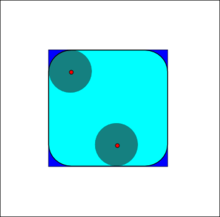Opening (morphology)

In mathematical morphology, opening is the dilation of the erosion of a set A by a structuring element B:
where  and
and  denote erosion and dilation, respectively.
denote erosion and dilation, respectively.
Together with closing, the opening serves in computer vision and image processing as a basic workhorse of morphological noise removal. Opening removes small objects from the foreground (usually taken as the dark pixels) of an image, placing them in the background, while closing removes small holes in the foreground, changing small islands of background into foreground. These techniques can also be used to find specific shapes in an image. Opening can be used to find things into which a specific structuring element can fit (edges, corners, ...).
One can think of B sweeping around the inside of the boundary of A, so that it does not extend beyond the boundary, and shaping the A boundary around the boundary of the element.
Properties
- Opening is idempotent, that is,
 .
. - Opening is increasing, that is, if
 , then
, then  .
. - Opening is anti-extensive, i.e.,
 .
. - Opening is translation invariant.
- Opening and closing satisfy the duality
 , where
, where  denotes closing.
denotes closing.
See also
Bibliography
- Image Analysis and Mathematical Morphology by Jean Serra, ISBN 0-12-637240-3 (1982)
- Image Analysis and Mathematical Morphology, Volume 2: Theoretical Advances by Jean Serra, ISBN 0-12-637241-1 (1988)
- An Introduction to Morphological Image Processing by Edward R. Dougherty, ISBN 0-8194-0845-X (1992)
External links
- http://homepages.inf.ed.ac.uk/rbf/HIPR2/open.htm - Morphological Opening
